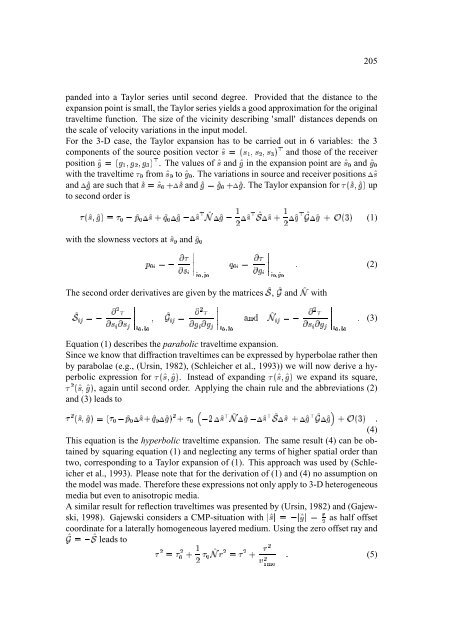Annual Report 2000 - WIT
Annual Report 2000 - WIT
Annual Report 2000 - WIT
Create successful ePaper yourself
Turn your PDF publications into a flip-book with our unique Google optimized e-Paper software.
Ý<br />
ã<br />
ä<br />
and ã<br />
with the slowness vectors at ã äñ<br />
and ã î§ñ<br />
Þ<br />
§<br />
ò<br />
䨥 §<br />
¤ ¦<br />
©©©©©<br />
û<br />
ã<br />
ã<br />
Ý<br />
. The Taylor expansion for ò æ ã ä¡ê ã<br />
î<br />
þ ã<br />
§<br />
ò<br />
î¥ §<br />
The second order derivatives are given by the ã þ<br />
matrices<br />
ã þ ¥qå<br />
Þ<br />
§<br />
ä¥ § ä §<br />
<br />
©©©©©<br />
ê<br />
§<br />
î¥ § î¨ §<br />
ý<br />
<br />
©©©©©<br />
û<br />
ã<br />
,<br />
*<br />
Ý<br />
¤ <br />
©©©©©<br />
ã , ã<br />
û<br />
and<br />
ã<br />
û ¥qå<br />
Ý<br />
Þ<br />
<br />
§<br />
ä¥ § î¨ §<br />
Ý<br />
<br />
©©©©©<br />
<br />
ä<br />
205<br />
panded into a Taylor series until second degree. Provided that the distance to the<br />
expansion point is small, the Taylor series yields a good approximation for the original<br />
traveltime function. The size of the vicinity describing 'small' distances depends on<br />
the scale of velocity variations in the input model.<br />
For the 3-D case, the Taylor expansion has to be carried out in 6 variables: the 3<br />
components of the source position ã vector<br />
äÒåçæèä§égê ä<br />
ê äë ìí<br />
and those of the receiver<br />
position ã<br />
ê×î ê×î§ë ì í<br />
. The values of ã ä<br />
and ã î<br />
in the expansion point are ã äñ<br />
and ã î§ñ<br />
îåïæðîé<br />
with the ò ñ<br />
traveltime ã äñ<br />
from ã to<br />
ó¿ã and<br />
to second order is<br />
î<br />
are such that ã<br />
äñõô óµã<br />
î§ñNô ó¿ã<br />
. The variations in source and receiver positions óµã<br />
î§ñ<br />
up<br />
îZì<br />
ä„å<br />
îzå<br />
ó¿ã äÿô<br />
ý óqã î í ã ó¿ã î ô¢¡æ¤£©ì<br />
(1)<br />
ü<br />
ò æ ã ä©ê ã îZìöå<br />
ò ñ Þ÷ã øùñ óµã äÎô<br />
ú²ñ óqã î Þµóµã ä í<br />
ã<br />
î Þ‚ü ý óµã ä í<br />
óqã<br />
(2)<br />
ú²ñ¦¥õå<br />
øùñ¦¥å<br />
with<br />
(3)<br />
Ý ò<br />
Ý ò<br />
Ý ò<br />
ã ¥¿å<br />
<br />
Equation (1) describes the parabolic traveltime expansion.<br />
Since we know that diffraction traveltimes can be expressed by hyperbolae rather then<br />
by parabolae (e.g., (Ursin, 1982), (Schleicher et al., 1993)) we will now derive a hyperbolic<br />
expression for ò æ ã<br />
îZì<br />
we expand its square,<br />
ò Ý æ ã ä©ê ã<br />
ã îZì<br />
. Instead of expanding ò æ ã äê ã<br />
ä©ê<br />
, again until second order. Applying the chain rule and the abbreviations (2)<br />
îZì<br />
and (3) leads to<br />
ò Ý æ ã ä©ê ã îZìå<br />
æ ò ñ Þ’ã ø•ñ ó¿ã ä•ô<br />
ú€ñ ó¿ã îZì Ý ô ã<br />
ò ñ! Þ<br />
óµã ä í<br />
î Þ—ó¿ã ä í ã þ<br />
óµã äô ó¿ã<br />
óqã î í ã óqã î#" ô$¡Òæ%£¡ì<br />
(4)<br />
<br />
This equation is the hyperbolic traveltime expansion. The same result (4) can be obtained<br />
by squaring equation (1) and neglecting any terms of higher spatial order than<br />
two, corresponding to a Taylor expansion of (1). This approach was used by (Schleicher<br />
et al., 1993). Please note that for the derivation of (1) and (4) no assumption on<br />
the model was made. Therefore these expressions not only apply to 3-D heterogeneous<br />
media but even to anisotropic media.<br />
A similar result for reflection traveltimes was presented by (Ursin, 1982) and (Gajewski,<br />
1998). Gajewski considers a CMP-situation &ðã ä & å Þ'& ã î & å)(<br />
with as half offset<br />
coordinate for a laterally homogeneous layered medium. Using the zero offset ray and<br />
leads to<br />
ã å Þ ã þ<br />
ý ò ñ ã<br />
û+*<br />
ü<br />
(5)<br />
ò Ý å<br />
ò Ý ñ ô<br />
Ý å<br />
ò Ý ô<br />
-/.10







